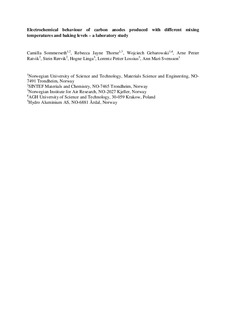| dc.contributor.author | Sommerseth, Camilla | |
| dc.contributor.author | Thorne, Rebecca Jayne | |
| dc.contributor.author | Gebarowski, Wojciech | |
| dc.contributor.author | Ratvik, Arne Petter | |
| dc.contributor.author | Rørvik, Stein | |
| dc.contributor.author | Linga, Hogne | |
| dc.contributor.author | Lossius, Lorentz Petter | |
| dc.contributor.author | Svensson, Ann Mari | |
| dc.date.accessioned | 2020-02-05T12:42:19Z | |
| dc.date.available | 2020-02-05T12:42:19Z | |
| dc.date.created | 2019-06-18T13:00:09Z | |
| dc.date.issued | 2019 | |
| dc.identifier.isbn | 978-3-030-05864-7 | |
| dc.identifier.uri | http://hdl.handle.net/11250/2639830 | |
| dc.description.abstract | Anodes fabricated from a single source coke were used for investigations of effect of porosity and surface roughness on the electrochemical performance in laboratory scale cells. In order to fabricate anodes differing in porosity, the production parameters were varied with two levels of mixing temperatures (150 and 210 °C) and three baking levels (underbaking at 1150°E, normal baking at 1260°E, overbaking at 1350°E). °E denotes the equivalent temperature which is a function of both the temperature the anode sees, and the time kept at this temperature. The low mixing anodes were more inhomogeneous with respect to both micro- and macroporosity, which can be attributed to the wetting between pitch and coke. After electrolysis, the real surface area of the low mixing anodes was about 13% higher than the high mixing anodes. Also, the low mixing electrodes had slightly larger electrochemically active surface area after electrolysis compared to the high mixing electrodes, as evidenced by higher capacitance measured at low current densities. Still, the mixing and equivalent baking temperatures did not affect the electrochemical overpotential at 1 A/cm2 to any significant extent. This could be understood from the 3D computed tomography images, which also showed that the electrolyte does not generally penetrate into the pores on the surface, penetration will depend on the size and shape of the pore. | nb_NO |
| dc.language.iso | eng | nb_NO |
| dc.publisher | Springer Verlag | nb_NO |
| dc.relation.ispartof | Light Metals 2019 | |
| dc.title | Electrochemical Behaviour of Carbon Anodes Produced with Different Mixing Temperatures and Baking Levels—A Laboratory Study | nb_NO |
| dc.type | Chapter | nb_NO |
| dc.description.version | acceptedVersion | nb_NO |
| dc.source.pagenumber | 1311-1318 | nb_NO |
| dc.identifier.doi | https://doi.org/10.1007/978-3-030-05864-7_161 | |
| dc.identifier.cristin | 1705682 | |
| dc.relation.project | Norges forskningsråd: 200588 | nb_NO |
| dc.description.localcode | This is a post-peer-review, pre-copyedit version of an article. Locked until 16.2.2020 due to copyright restrictions. The final authenticated version is available online at: https://doi.org/10.1007/978-3-030-05864-7_161 | nb_NO |
| cristin.unitcode | 194,66,35,0 | |
| cristin.unitname | Institutt for materialteknologi | |
| cristin.ispublished | true | |
| cristin.fulltext | postprint | |
| cristin.qualitycode | 1 | |
